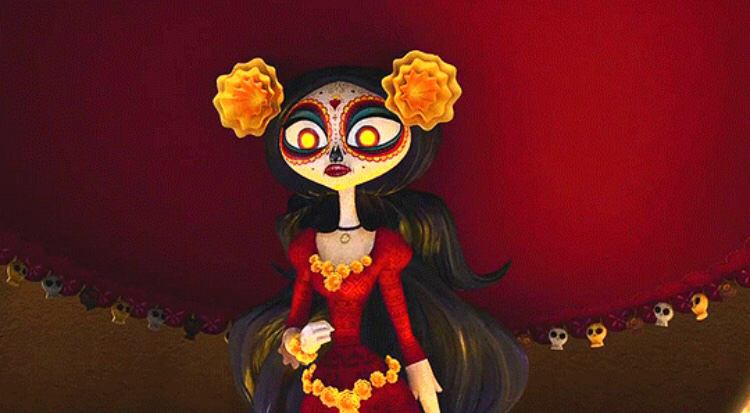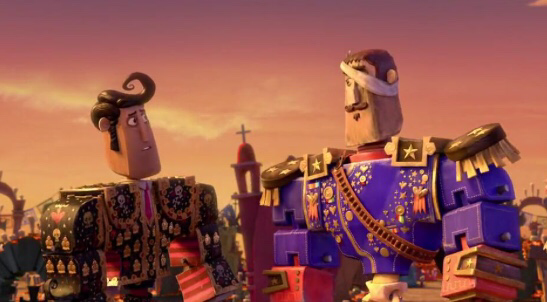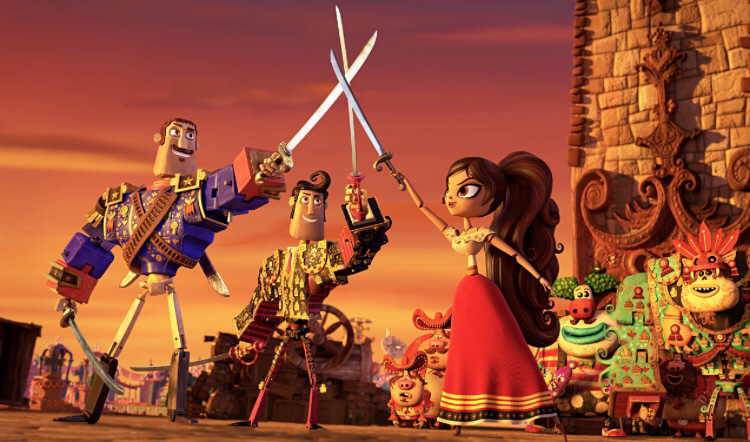Hello movie fans!
As you know, the spookiest holiday of all, Halloween, was celebrated on Tuesday. However, if you are Mexican, like me, you may have also celebrated Día de los Muertos, or the Day of the Dead. From October 31 to November 2, it is believed that the spirits of past loved ones are allowed to revisit the land of the living and be reunited with their relatives. This return is highly celebrated in Mexican culture, and Día de los Muertos is one holiday in particular that is filled with happiness, love, and color. This week’s movie is inspired by traditional celebrations of Día de los Muertos, and with so much rich culture to draw from, it is no wonder why this movie is so phenomenal. Today I’ll be reviewing The Book of Life, one of my favorite movies that tells one of my favorite stories. (Also, there WILL be spoilers!)
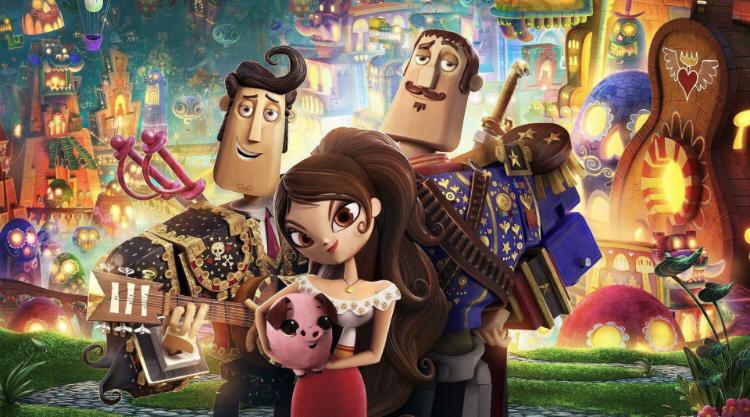
The art style of The Book of Life is beautiful, and full of vibrant colors and textures. Much of the visual elements are real life symbols of Día de los Muertos. The design of the character La Muerte is a clear example of that. Her design is based off of the sugar skulls that are made in preparation for the holiday, and her dress is adorned with marigolds, the traditional flower of the dead.
A lot of different aesthetics were used in tje character design, including those of the Aztecs and Spanish conquistadors.
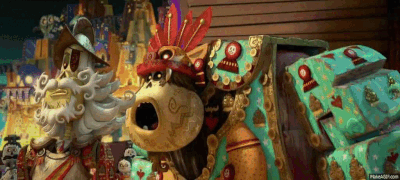
There is also something about the character design that sets The Book of Life apart: the characters in Manolo’s story are designed to look like wooden dolls. They generally have blocky bodies and jointed arms and legs, and textures reminiscent of actual wood. Each character is unique, and retains the beauty of genuine craftsmanship in an animated form.
The music, too, is beautiful and carries some references to the culture the movie is based in. Latinized covers of Mumford and Sons’ “I Will Wait” and Radiohead’s “Creep” serve as part of the soundtrack, which is filled with original songs. The main character, Manolo, does a lot of singing, considering that music is his passion. His voice is provided by Diego Luna, who can sing with the voice of an angel in my professional opinion. “The Apology Song” supports this beyond shadow of a doubt. With a soft tenderness and conviction, Manolo asks forgiveness from a massive bull that he was meant to fight. The importance of this scene will be explained later on, but the performance of Diego Luna in this song adds an immeasurable amount of emotional pull to an already emotional scene.
As I mentioned before, the story that The Book of Life tells is one of my favorites. The story starts with a group of kids going to the museum on a field trip, and a kind-hearted tour guide shows them a special section of the museum, where she begins telling them the story of Manolo and his friends. This is how the framing device that is used throughout the movie is set up. In examples of successful uses of this classic storytelling device, well, this one is right up there with The Princess Bride.
The plotline, too, is very well executed. The Book of Life tells the story of a trio of friends: Manolo Sanchez, María Posada, and Joaquin Mondragon. The fate of the world is placed on their shoulders when the two rulers of the underworld, La Muerte and Xibalba, place bets on which boy will end up marrying María. If La Muerte wins and Manolo marries her, Xibalba must not interfere with the lives of people in the Land of the Living. If Xibalba wins and Joaquin marries her, Xibalba will rule over the cheerful Land of the Remembered and La Muerte will rule over the dreary Land of the Forgotten. Xibalba cheats by giving Joaquin a medal that prevents him from being hurt or killed, and is also coveted by the evil Chakal, leader of the banditos. The years pass, and while María is studying at a convent in Spain, Joaquin trains to become a star general in order to follow in his father’s footsteps, and Manolo is forced to follow in his father’s footsteps as a bullfighter, when his real passion lies in being a musician. Upon her return, María falls for Manolo, but María’s father wants her to marry Joaquin in order to keep him in their town and have him protect them from Chakal. Manolo proposes anyway, but Xibalba once again cheats by sending a snake to bite María. Everyone believes she is dead, but she has only fainted. In order to see his love again, Manolo dies for real and is sent to the Land of the Remembered. With Manolo dead, María ends up marrying Joaquin and Xibalba wins the bet, even though he cheated. Now, it is up to Manolo to find La Muerte in the Land of the Forgotten where she now resides so he can return again to the Land of the Living and be with his love. There is a lot of complexity to this plot, but it is executed so well that is adds depth to the story that the viewer can appreciate, and does not create a wild storyline that only brings confusion. The ability to have such complex story and not allow it to devolve into a weird mess takes an incredibly dedicated writer, which is another part of what makes The Book of Life so spectacular.
Like the story, the characters of The Book of Life have an immense depth and realness to them, and each carries an individual message that is important to teach the children of today. Joaquin Mondragon is an egotistical macho man, who strives to be a hero mainly to make himself look better. By the end of the film, some extreme character growth takes place. Banditos are attacking San Angel for the medal Joaquin wears for protection. As Manolo is about to sacrifice himself to kill Chakal, Joaquin slips the medal onto him, and without it, Joaquin loses an eye, but Manolo survives. In the end, Joaquin learns that a true hero is selfless and helps others in order to make the world happier.
María Posada is a bright young woman, who is fierce and determined in her ways. Her message is simple: women are not objects or a prize to be won; they are people, and should be respected as such. There is one moment in particular where María stands up to Joaquin after he says she would “make a good wife” and that he mainly sees women as prospective wives. It is a strong scene that defines María’s character and makes sure this message is set in stone.
Manolo Sanchez is a young man with a passion for singing and music, and dreams of being a musician. However, he comes from a huge family of bullfighters, and his father wants him to become a bullfighter as well. Manolo doesn’t want to disappoint his father, but he knows that he can never be a real bullfighter because he cannot kill a bull, and it’s not his dream to be a world famous bullfighter- it’s his father’s. His father knows his son’s real passion is music, but he disregards that in favor of making Manolo into a proper Sanchez, of making Manolo into the man that he wants to see, not the man that he is. In the end, both men learn to accept that Manolo isn’t going to live to the expectations placed on him- he’s going to to his own way. This is where the importance of “The Apology Song” and the scene it is sung in comes into play. In this scene, Xibalba conjures up Manolo’s worst fear for him to fight, and in winning, Manolo is allowed to return to the Land of the Living. Thus, he resurrects all the bulls ever killed by the Sanchez family bullfighters. The bulls combine into one massive bull, and this is when Manolo realizes that he cannot fight it physically, and that he must defeat the bull his own way- through song. So in singing “The Apology Song”, Manolo is not just asking forgiveness for all the killing that his family has committed, he’s asking for forgiveness from his father because he cannot fight bulls like his father wants him to. We learn that Manolo’s greatest fear was accepting himself, and in asking for forgiveness for not being able to meet expectations, he is allowed to follow his own path and accept that fact about himself. Manolo’s message is more complicated that those of his companions- it is that it’s good to separate yourself from impossible expectations, if what is expected of you is not part of a life that will make you happy.
Along with the messages that each character provides, The Book of Life also carries a message that includes all of the others. It’s simple, and contrasts nicely with the complicated depth of the film. It’s the idea that love comes in many different forms. There’s romantic love, like that between Manolo and María, familial love like that between Manolo and his family, and even the love between friends that exists with our main trio. But there are also more complicated types of love, like the love of humanity that drives people like Joaquin to be heroes. There’s also self-love that comes from self-respect like that of Marían, and self-love that stems from self-acceptance like that of Manolo. Overall, The Book of Life is a movie about all kinds of love, and watching it is an absolutely wonderful way to enjoy a bit of Día de los Muertos.
